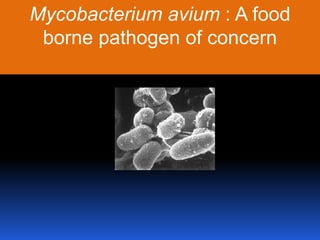
Mycobacterium paratuberculosis avium
- 1. Mycobacterium avium: A food borne pathogen of concern
- 2. History Paratuberculosis was first described in 1895 by Johneand Frothingham Identified in granulomatous lesions in the intestines of affected cattle that stained acid-fast indicating of Mycobacterial organism . The organism was cultured from cattle in 1910 and was classified as a Mycobacterium by Twort and Ingram (1910, 1912)
- 3. Mycobacterium aviumsubspecies paratuberculosis (MAP) Gram positive rod (0.5 x 1.5 micron) Acid fast Facultative intracellular Obligate parasitic pathogen Requires iron for growth
- 4. Virulence Factors Intracellular pathogen Grow and multiply inside macrophages Chemically resistant Mycobacterial cell wall that is resistant to destruction or penetration Ability to neutralize antibacterial chemicals produced inside macrophages Toxic chemical components of the Mycobacterial cell wall
- 7. Enables the development of new generations of diagnostic tests for Johne's disease. (Bannantineet al., 2005)
- 8. Natural Reservoirs Natural reservoir – wild animal population (Ruminants, Swine, Rabbit, Deer, Bison, Elk) MAP can survive – 250 days in water feces, cattle slurry Manure from infected animal most common mode of contamination Vertical transmission during pregnancy
- 9. Disease Digestive tract route of entrance of MAP Multiplication of MAP in Intestinal mucosa Phagocytosis by macrophages Via lymph channels Infiltration regional lymph node
- 10. Cause Decreased absorption & chronic diarrhea Muscle wasting and loss of weight Severity leads to death Leads to : Reduced milk yield Reduced meat yield Reduced reproductive performance
- 11. Potential Human Exposure to MAP
- 12. Presence of MAP in Milk & Milk Products MAP has been detected in the following : Colostrum Raw Milk Pasteurized Milk Powdered Milk Cheese Goat and Sheep Milk
- 13. MAP in Colostrum Colostrum good sample for MAP isolation Early potential exposure of dairy calf MAP detected in udder tissue supramammary lymph nodes (Chiodiniet al, 1984) (Streeter et al, 1995)
- 16. Mixing contaminated milkMAP isolated from – Supramammary lymph node; deep udder tissue (Sweeney et al ., 1992)
- 17. Incidence of MAP in Raw Milk
- 20. Survival: Heat Resistance In most cases a 3 - 4 log kill Achieved with Pasteurisation Survival depends on initial contamination level
- 22. Children's at higher risk
- 23. Crohn’s disease in children's in Europe, 2004
- 25. Occurrence of MAP in Cheese by PCR Greece 50 % CZ 12 % USA 5 % (Ayeleet al, 2004)
- 26. MAP in Sheep & Goat Raw Milk 104 sheep and goat milk sample analyzed in UK PCR - 1%(Grant et al, 2001) 340 goat milk sample analyzed in Norway IMS-PCR- 7.1 %(Djanneet al, 2003) In India, MAP isolated from milk and feces of infected goat (Singh and Vihan 2004)
- 27. Effect of Food Processing Steps on MAP Clarification, centrifugation, separation, standardization and homogenization Homogenization – increases MAP count Centrifugation and microfiltration – removes MAP 95-99.9% (Grant et al, 2005) Homogenization and Pasteurization – more effective for MAP inactivation (Grant et al, 2005)
- 28. Processing of Dairy Products NaCl has little or no effect in cheese Low pH significantly contribute MAP inactivation Ripening of cheese significantly lower MAP Temp and low pH – most important factor in MAP inactivation during ripening Persistence of MAP in cheese High conc. of MAP in raw milk Short ripening period (Spahr and Schafroth, 2001)
- 29. MAP in Retail Dairy Products
- 35. MAP Detection-Culture Method Media –Herrold’s Egg Yolk Medium (HEYM) Antibiotics- PANTA- Polymyxin B, Amphotericin B, Nalidix Acid, Trimethoprin, Azocillin VAN - Vancomycin, Amphoterin B, Nalidxic Acid Additive- Mycobactin J Decontamination of sample: 1) NaOH 2) HPC
- 38. Drawbacks PCR inhibitors - present in fecal, milk, milk product samples Cant differentiate between live and dead cell Chances of cross amplification Some protocols lack sensitivity
- 39. ELISA ELISA tests based on: IFN–Υ - Expression of IFN-Υincreases during infection Protoplasmic antigen (PPA-3) – first used antigen (Sweenayet al 1994) Lipoarabinomannan polysaccharide antigen (LAM)
- 43. Antibiotic therapy – No complete cure
- 44. Antibiotics used - Clofazimine or Isoniazid and either Rifabutin or EthambutolTreatment of goat affected with MAP Streptomycin, Rifampicin, Levamisole (Das et al, 1992)
- 45. Vaccination Heat killed or modified live preparation of M. paratuberculosis strain 18- reduces incidence Provides partial protection Decreases the No. of MAP shedding in feces (Kormendy, 1994) Disadvantage Positive antibody test, which may interfere with serological testing
- 46. Management Over all cleanliness of farm Manure handling Care of new borne calf Breed selection – jersey and Cuernsey more susceptible Routine check up – ELISA, PCR
- 47. MAP a human pathogen ? Chron’s disease in human, a sever inflammatory enteritis involving the terminal ileum Clinical symptoms of Crohn’s disease closely mimic those found in animals with Johne’s disease M. paratuberculosis has been isolated from biopsy tissues Crohn’s disease patients Epidemiological evidence correlating exposure to M. paratuberculosis with incidence of Crohn’s disease is not readily available (Stabel, 1997)
- 49. Map growth was inhibited (delayed) when supplemented with supernatants from a number of Lb. paracasei isolates
- 50. When co-inoculated with probiotic strains in sterile milk for 48 h (pH < 4.5) MAP could not be detected by culture method up to 50 days